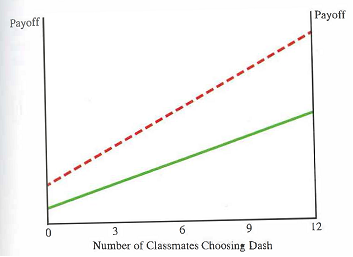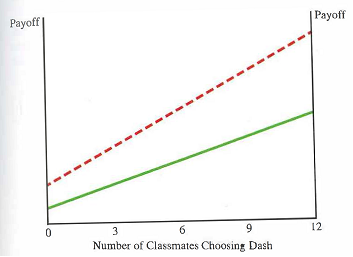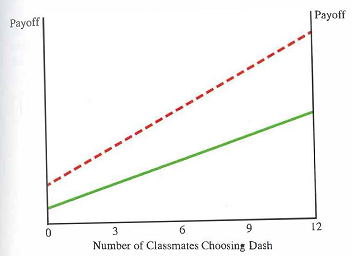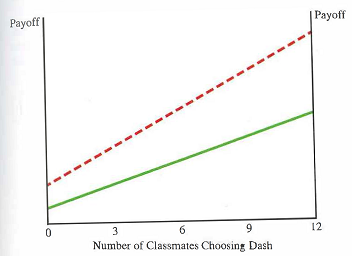
Economic Analysis of Social Issues 1st Edition by Alan Grant
Edition 1ISBN: 978-0134098371
Economic Analysis of Social Issues 1st Edition by Alan Grant
Edition 1ISBN: 978-0134098371 Exercise 28
Consider the game played by 13 students in questions 1 to 4. Use that information to answer the following two question : Which of the following are equilibrium outcomes in this game?
A) All solid
B) All dash
C) Half solid and half dash
D) Both a and b are equilibrium outcomes.
Question 1:
For question, consider the following game. There are 13 students in the class, including you. Each student must choose either solid or dash. Payouts to solid and dash are indicated by the appropriate lines in the graph below:

If all of your classmates choose dash, what should you choose?
A) Solid
B) Dash
C) Both solid and dash give you the same payoff, so it doesn't matter which you choose.
Question 2:
For question, consider the following game. There are 13 students in the class, including you. Each student must choose either solid or dash. Payouts to solid and dash are indicated by the appropriate lines in the graph below:

If all of your classmates choose solid, what should you choose?
A) Solid
B) Dash
C) Both solid and dash give you the same payoff, so it doesn't matter which you choose.
Question 3:
For question, consider the following game. There are 13 students in the class, including you. Each student must choose either solid or dash. Payouts to solid and dash are indicated by the appropriate lines in the graph below:

Suppose that exactly half (six) of your classmates have chosen dash. What should you choose?
A) Solid
B) Dash
C) Both solid and dash give you the same payoff, so it doesn't matter which you choose.
Question 4:
For question, consider the following game. There are 13 students in the class, including you. Each student must choose either solid or dash. Payouts to solid and dash are indicated by the appropriate lines in the graph below:

Suppose that exactly half (six) of your classmates have chosen dash. Who among your classmates will wish to change their minds?
A) The ones who chose solid
B) The ones who chose dash
C) Nobody wishes to change their mind.
D) Everybody wishes to change their mind.
A) All solid
B) All dash
C) Half solid and half dash
D) Both a and b are equilibrium outcomes.
Question 1:
For question, consider the following game. There are 13 students in the class, including you. Each student must choose either solid or dash. Payouts to solid and dash are indicated by the appropriate lines in the graph below:

If all of your classmates choose dash, what should you choose?
A) Solid
B) Dash
C) Both solid and dash give you the same payoff, so it doesn't matter which you choose.
Question 2:
For question, consider the following game. There are 13 students in the class, including you. Each student must choose either solid or dash. Payouts to solid and dash are indicated by the appropriate lines in the graph below:

If all of your classmates choose solid, what should you choose?
A) Solid
B) Dash
C) Both solid and dash give you the same payoff, so it doesn't matter which you choose.
Question 3:
For question, consider the following game. There are 13 students in the class, including you. Each student must choose either solid or dash. Payouts to solid and dash are indicated by the appropriate lines in the graph below:

Suppose that exactly half (six) of your classmates have chosen dash. What should you choose?
A) Solid
B) Dash
C) Both solid and dash give you the same payoff, so it doesn't matter which you choose.
Question 4:
For question, consider the following game. There are 13 students in the class, including you. Each student must choose either solid or dash. Payouts to solid and dash are indicated by the appropriate lines in the graph below:

Suppose that exactly half (six) of your classmates have chosen dash. Who among your classmates will wish to change their minds?
A) The ones who chose solid
B) The ones who chose dash
C) Nobody wishes to change their mind.
D) Everybody wishes to change their mind.
Explanation
As per above graph, line y (solid line) ...
Economic Analysis of Social Issues 1st Edition by Alan Grant
Why don’t you like this exercise?
Other Minimum 8 character and maximum 255 character
Character 255



